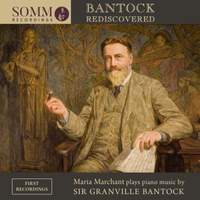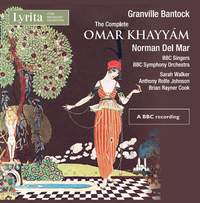Interview,
Maria Marchant on Granville Bantock
 Granville Bantock is one of those composers who, despite earning great fame and acclaim during his own lifetime, has fallen into relative obscurity since. Successor to Elgar at Birmingham University and co-founder of the City of Birmingham Symphony Orchestra, his best-known work today is probably his lush orchestration of Bach's 'Wachet auf, ruft uns die Stimme'.
Granville Bantock is one of those composers who, despite earning great fame and acclaim during his own lifetime, has fallen into relative obscurity since. Successor to Elgar at Birmingham University and co-founder of the City of Birmingham Symphony Orchestra, his best-known work today is probably his lush orchestration of Bach's 'Wachet auf, ruft uns die Stimme'.
Bantock was, however, a prolific and wide-ranging composer in his own right, with numerous Romantic, often exotically-tinged, works for both orchestral and smaller forces. His monumental choral symphony Omar Khayyám, setting Edward FitzGerald's translations of the 11th-century Rubaiyat, was a particularly popular work – recently appearing in its first-ever complete recording on Lyrita.
Together with Somm Records, Maria Marchant is leading the charge for a reassessment of Bantock's style - her latest album showcases his compositions for solo piano. I asked Maria how she sees him in relation to some of his contemporaries, and what obstacles still remain to be overcome in rehabilitating his music.
The sleeve notes mention Sibelius dedicating his Third Symphony to Bantock. These two composers seem utterly different in style and outlook: what do you think Sibelius saw in Bantock’s music to admire so strongly?
Well, they were very good friends, and Bantock was actually key in introducing Sibelius’ music to the UK. He arranged a tour that saw Sibelius come to the UK; they knew each other and had an enormous amount of respect for each other’s music, and I think it really stems from that.
That said, Sibelius also wrote lots of miniature piano pieces too – not all of Bantock’s piano works are short, but he seemed to savour that kind of music – so there’s a link there as well. So many of the composers at that time were writing less for the piano – the likes of Elgar, Mahler, Strauss, Stravinsky, they were all writing for big orchestras. Of course they did write for the piano, but less so. Sibelius and Bantock both kept writing small-scale piano works, so they had that in common besides being friends.
These works have never been recorded before. While Bantock’s large-scale orchestral works may have been casualties of post-WWI financial belt-tightening, this can’t be the case for his solo piano music; why do you think he fell so thoroughly out of favour, in a way that similar composers such as Elgar or Delius did not?
It's an interesting question – this whole album is indeed comprised of first recordings – and what I discovered when I came across the scores and started working through them is that they harken back to the Romantic era. Not just the late-eighteenth-century works like Saul and the Twelve Piano Pieces, but even the later ones like Midnight Cloisters and Memories of Sapphire, which is the latest one on the album and dates from 1938 – they still sound like they’ve come out of that wonderful era of piano music.
So at the time, if you think about 1938 and what was happening, it might well not have been seen as very progressive and there wasn’t the same market for it. They were all published at one time or another, but they then just went out of fashion and out of print.
The major work on the album is the twelve-minute piano version of Bantock’s Saul overture. Do you feel that a different side of Bantock’s compositional style comes out in this large-scale, originally orchestral piece, compared with the smaller ones written for the piano?
Yes, absolutely. One of the reasons I was so keen for Saul to be on the album was to show that different side. It’s his own transcription, rather than someone else’s. For a start it’s longer – it’s a very programmatic work, based on events in 1 Samuel, and Bantock even quotes that book on the score itself. Unbelievably, we couldn’t find a recording of the orchestral version, to hear it in its original form! I don’t think it’s actually been recorded, which is extraordinary. But it starts with an obvious brass timbre and sounds incredibly orchestral; you can hear a moment when the strings come in. It’s almost Wagnerian, a very dramatic, virtuosic work, so it’s enormously different from the other pieces.
It’s also very difficult to play, too! There are a lot of notes. But there’s always intent behind them – it’s a real heart-on-sleeve work, whereas some of the other pieces are perhaps more leaning towards a witty feeling, this is a much more passionate piece. It’s an early work – the earliest on the album, dating from 1894 – but I think it’s an enormously powerful example of what he could write.
It’s easy to slip into thinking of this sort of music as simply ‘nice’ – superficial ear-pleasers of no real profundity, operating on a completely different level to the Romantic symphony or verismo opera. Is this fair, or do you think there are deeper undercurrents to be detected in Bantock’s piano works?
I can understand how they could be heard in that way. The term ‘light music’ is often bandied around, and it’s a very dangerous term – who knows what is really meant by a term like that? But for me, the reason why I picked Saul and the Scottish Pieces was to show that Bantock wasn’t just a composer who wrote what might be called ‘salon’ music. Take the Scottish Pieces, particularly the first one (The Hills of Glenorchy) – it’s completely unplayable! It’s on three staves, and you’d need an extra pair of hands to play it, so we had to work out a way round that. And similarly the second, at the end when it goes into that octave folksong variation – there’s no way that could be seen as any kind of light, nice piece. But at the same time, the set of twelve pieces shows that he was capable of writing those charming works as well. So I’ve tried to get a full spectrum of what he could actually do.
But within those works, with Reverie and Chanson de Mai for example, I think there’s a great beauty in the way the phrases interweave similar to Elgar’s charming Salut d’Amour; Chanson de Mai reminds me particularly of Elgar’s Salut d’Amour, again very charming stuff. And of course Elgar knew Bantock – he recommended him as his successor at Birmingham University as Peyton Professor of Music. In the British Library there’s a painting that I was thrilled to come across – a Samuel Begg composite portrait of all the significant British composers of the time, and Bantock’s there alongside Elgar, Macfarren, Cyril Scott and other names like that. It’s been a fascinating journey.
I think in the same way that we have Elgar’s Salut d’Amour there are equivalent works by Bantock. The Barcarolle, with that quote from Browning’s In a gondola at the head of the score, is particularly interesting. The poem is all about little elves inside the harp sounding the strings which really made sense – the image of these elves flitting about inside the piano was a very evocative one to have in my head while I played, and it’s a wonderful work.
He’s somebody who had a lot of ideas – think of the heightened Romanticism of Memories of Sapphire. The second movement is probably my favourite, but the third has such a sense of wit about it as well, so really there’s a great scope and we tried to get as wide a selection in as we could, to showcase all his different compositional tendencies. It’s just amazing that none of these pieces have been recorded before – we were really surprised.
Do you think Bantock is being rehabilitated somewhat today, or is there still some way to go in bringing his name back into the musical history books?
I think there’s a huge way to go! We’ve barely started. This year is the 150th anniversary of his birth, but can any of us name a Bantock celebration that’s going on this year? It’s extraordinary if you think about what an important historical figure he was – he co-founded the CBSO, among other things, and in fact Saul was one of the first pieces they played – so it’s strange that so much of his music is still waiting to be heard.
It’s up to listeners and critics now what they think of the music of course, not just the musicians themselves, but it is my belief that this music deserves to be performed internationally in the concert platform. As I said to Bantock’s grandson Cuillin – who has been enormously helpful with this project – when we were figuring out how to track down the printed music, I think one of the main reasons pianists don’t play Bantock is that it’s so hard to get the scores! Much of it is out of print, and that needs to change too. It needs to be more accessible, it needs to be played more, and I’m very grateful to the SOMM team, particularly Siva Oke and Paul Arden-Taylor for having the vision and courage to put on disc this previously virtually untapped repertoire. People just don’t know about it, to an extent that I couldn’t believe when I started looking at the music. So we’ve really only just started...
Bantock Rediscovered was released on Somm on 1st June.
Available Formats: CD, MP3, FLAC, Hi-Res FLAC
Marchant's previous album - also on Somm - explores piano music by British composers past and present, with works by Britten, Holst, Ireland and Roderick Williams.
Available Formats: CD, MP3, FLAC, Hi-Res FLAC
Omar Khayyám
Sarah Walker (contralto), Anthony Rolfe Johnson (tenor) & Brian Raynor Cook (baritone), BBC Scottish Symphony Orchestra, Norman Del Mar
Norman del Mar's 1979 radio performance of the complete Omar Khayyám was the culmination of a massive musicological project. Though several partial accounts already existed, Lyrita's 2016 release of this recording was, and remains, the only one to present the full, unabridged work.
Available Formats: 4 CDs, MP3, FLAC





